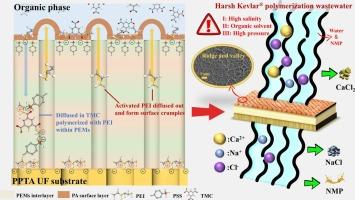研究 PPTA/PEMs/PA 复合 NF 膜对高盐度 Kevlar® 盐水的高效脱盐和长期抗结垢性能
IF 8.3
1区 工程技术
Q1 ENGINEERING, CHEMICAL
引用次数: 0
摘要
在 Kevlar® 的聚合过程中会产生大量有机盐水,其中含有 N-(1-甲基-2-吡咯烷酮)(NMP)以及高浓度的 CaCl2 和 NaCl。废水直接排放会对水和土壤资源造成严重污染。无机盐的分离与回收一直是工业难题。本文基于绿色自循环的新理念,以聚对苯二甲酰对苯二胺(PPTA,Kevlar® 的树脂)超滤膜为基材,复合疏松卷曲的聚电解质多层膜(PEMs)作为夹层,通过界面聚合形成均质的聚酰胺分离层,由此得到均质增强芳纶复合纳滤膜(NF)。不同夹层数的复合纳滤膜显示出不同的优势。对于单组分盐水,PEMs-1/PA 膜对 10 g/L CaCl2 和 MgSO4 的截留率分别为 93 % 和 98.4 %。对于 20 g/L CaCl2 和 NaCl 混合盐水,PEMs-3/PA 膜对 CaCl2 和 NaCl 的截留率分别为 87.13 % 和 1.05 %,分离因子高达 82.95。在长期使用稳定性测试中,PEMs-3/PA 膜在 4 个周期共 160 小时的使用中保持了稳定的性能,纯水反冲洗仅 0.5 小时后渗透率几乎完全恢复。令人惊喜的是,该研究获得的 PPTA NF 膜能有效处理 Kevlar® 聚合过程中的高盐度盐水,在处理盐水工业废水方面具有更广阔的前景。本文章由计算机程序翻译,如有差异,请以英文原文为准。

Study on PPTA/PEMs/PA composite NF membranes for highly efficient desalination of high-saline Kevlar® brine and long-term anti-scaling performance
It produces a large number of organic brine during the polymerization process of Kevlar®, which contains N-(1-Methyl-2-pyrrolidinone) (NMP) and high concentrations of CaCl2 and NaCl. The wastewater will cause serious pollution of water and soil resources if discharged directly. The separation and recycling of inorganic salts have been an industrial difficulty. In this paper, based on the novel concept of green self-recycling, we used Poly (p-phenylene terephthamide) (PPTA, resin of Kevlar®) ultrafiltration membrane as the substrate, composited the loose and curled polyelectrolyte multilayers (PEMs) as interlayers and formed a homogeneous polyamide separation layer through interfacial polymerization, from which we obtained the homogeneous reinforcement aramid composite nanofiltration (NF) membrane. The composite NF membranes with different interlayer numbers showed different advantages. For single-component brine, the retentions of PEMs-1/PA membrane were 93 % and 98.4 % for 10 g/L CaCl2 and MgSO4 respectively. For mixed brine of 20 g/L CaCl2 and NaCl, the retentions of PEMs-3/PA membrane were 87.13 % and 1.05 % for CaCl2 and NaCl respectively with the separation factor as high as 82.95. In the test of long-term service stability, PEMs-3/PA maintained stable performance in 4 cycles total of 160 h. And the permeance could almost fully recover after pure water backwash of only 0.5 h. In addition, the structural stability and anti-scaling performance of the PEMs-3/PA membrane were further verified in high-temperature brine. Surprisingly, the obtained PPTA NF membrane in this work could effectively treat the high-saline brine in the Kevlar® polymerization process and would have more promising prospects in the treatment of industrial wastewater of brine.
求助全文
通过发布文献求助,成功后即可免费获取论文全文。
去求助
来源期刊

Desalination
工程技术-工程:化工
CiteScore
14.60
自引率
20.20%
发文量
619
审稿时长
41 days
期刊介绍:
Desalination is a scholarly journal that focuses on the field of desalination materials, processes, and associated technologies. It encompasses a wide range of disciplines and aims to publish exceptional papers in this area.
The journal invites submissions that explicitly revolve around water desalting and its applications to various sources such as seawater, groundwater, and wastewater. It particularly encourages research on diverse desalination methods including thermal, membrane, sorption, and hybrid processes.
By providing a platform for innovative studies, Desalination aims to advance the understanding and development of desalination technologies, promoting sustainable solutions for water scarcity challenges.
 求助内容:
求助内容: 应助结果提醒方式:
应助结果提醒方式:


